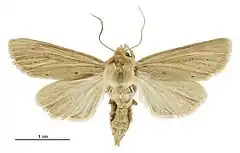Tmetolophota unica
Tmetolophota unica is a species of moth in the family Noctuidae. It is endemic to New Zealand. This moth is very similar in appearance to its close relative Tmetolophota phaula.
| Tmetolophota unica | |
|---|---|
 | |
| Male | |
 | |
| Female | |
| Scientific classification | |
| Kingdom: | |
| Phylum: | |
| Class: | |
| Order: | |
| Family: | |
| Genus: | |
| Species: | T. unica |
| Binomial name | |
| Tmetolophota unica (Walker, 1856) | |
| Synonyms | |
| |
Taxonomy
This species was first described by Francis Walker in 1856 using material collected at Waikouaiti by P. Earl and named Leucania unica .[1][2] In 1868 Achille Guenée, thinking he was describing a new species, named the species Nonagria juncicolor.[2] George Hudson discussed and illustrated this species under the name Leucania unica both in his 1898 book New Zealand moths and butterflies (Macro-lepidoptera),[3] and his 1928 publication The Butterflies and Moths of New Zealand.[4] In his 1898 publication Hudson synonymised the name given to the species by Guenée.[2][3] In 1971 John S. Dugdale transferred all the New Zealand species in the genus Leucania to the genus Tmetolophota.[5][2] The holotype specimen is held at the Natural History Museum, London.[2] In 2019 Robert J. B. Hoare published a paper in which he undertook a major review of New Zealand noctuids. Hoare, having inspected the type material of this species, placed it within the genus Ichneutica.[6]
Description
Edward Meyrick described the species as follows:
Male, female. — 34-35 mm. Head, palpi, antennae, thorax, abdomen, and legs whitish-ochreous, slightly brownish-tinged ; antennae in male moderately bipectinated, pectinations strongly ciliated. Forewings moderately dilated, costa almost straight, apex obtuse, hindmargin waved, somewhat oblique, rounded beneath ; whitish-ochreous, slightly brownish-tinged, sometimes with a few scattered black scales ; first Iine represented by three pairs of obscure black dots ; a posterior curved series of black dots : cilia whitish-ochreous. Hindwings grey, more or less tinged with whitish-ochreous ; cilia pale whitish-ochreous.[7]
This species is very similar in appearance to T. phaula but do not have the dentate antennae in the male of that species.[4]
Distribution

This species is endemic to New Zealand.[8] It has been found in the North Island at Waiouru and Ohakune and in the South Island at Blenheim, Raikaia, Quail Island, Dunedin, Lake Wakatipu, Alexandra and Macetown.[7][4][9]
Biology and behaviour
The species is on the wing from November to February.[4] It has been collected through sugar trapping.[4] This species is also attracted to light and specimens have been collected through light trapping.[10] It has been shown that artificial warming increases the body size of this moth.[11]
Habitat and host species
This species prefers open tussock habitat.[4] The larvae of this moth are herbivorous and feed on the leaves of grasses including those in the genus Poa.[12][9]
References
- Walker, Francis (1856). Gray, John Edward (ed.). List of the specimens of lepidopterous insects in the collection of the British Museum. Part IX - Noctuidae. London: British Museum (Natural History). Department of Zoology. p. 112.
- Dugdale, J. S. (1988). "Lepidoptera - annotated catalogue, and keys to family-group taxa" (PDF). Fauna of New Zealand. 14: 1–269. ISBN 978-0477025188. Retrieved 10 June 2018.
- Hudson, G. V. (1898). New Zealand moths and butterflies (Macro-lepidoptera). London. p. 12. doi:10.5962/bhl.title.7912. OCLC 727236768. Retrieved 10 June 2018.
- Hudson, G. V. (1928). The Butterflies and Moths of New Zealand. Wellington: Ferguson & Osborn Ltd. p. 52. OCLC 25449322.
- Dugdale, J.S. (1971). "Entomology of the Aucklands and other islands south of New Zealand: Lepidoptera, excluding non-crambine Pyralidae" (PDF). Pacific Insects Monograph. 27: 55–172.
- Hoare, Robert J. B. (2019-12-09). "Noctuinae (Insecta: Lepidoptera: Noctuidae) part 2: Nivetica, Ichneutica". Fauna of New Zealand. 80: 1–455. doi:10.7931/J2/FNZ.80.
- Meyrick, Edward (1887). "Monograph of New Zealand Noctuina". Transactions and Proceedings of the New Zealand Institute. 19: 3–40 – via Biodiversity Heritage Library.
- "Tmetolophota unica (Walker, 1856)". www.nzor.org.nz. Landcare Research New Zealand Ltd. Retrieved 2017-06-28.
- Patrick, H.J.H.; Bowie, M.H.; Fox, B.W.; Patrick, B.H. (2011). "The moths of Quail Island (Otamahua): a faunal comparison of an island under restoration with other sites on Banks Peninsula" (PDF). New Zealand Natural Sciences Journal. 36: 57–72.
- Patrrick, B. H.; Archibald, R. D. (January 1988). "Lepidoptera light-trapped at Owaka, South Otago" (PDF). New Zealand Entomologist. 11 (1): 70–72. doi:10.1080/00779962.1988.9722541. Archived from the original (PDF) on 9 February 2013. Retrieved 11 June 2018.
- Xi, Xinqiang; Yang, Yangheshan; Yang, Xiaocheng; Nylin, Sören; Eisenhauer, Nico; Sun, Shucun (13 November 2017). "Differential responses of body growth to artificial warming between parasitoids and hosts and the consequences for plant seed damage". Scientific Reports. 7 (1): 15472. doi:10.1038/s41598-017-15453-y. PMC 5684347. PMID 29133829.
- "PlantSynz - Invertebrate herbivore biodiversity assessment tool: Database". plant-synz.landcareresearch.co.nz. Retrieved 2018-06-11.
External links
| Wikimedia Commons has media related to Tmetolophota unica. |
| Wikispecies has information related to Tmetolophota unica. |